Mobile elevated work platforms, also known as aerial lifts or MEWPs, are popular on a variety of job sites. The American National Standards Institute (ANSI) defines a mobile elevated work platform as “a machine/device intended for moving persons, tools and material to working positions,” and consisting of a work platform with controls and an extending structure mounted on a mobile chassis.
In 2018, ANSI updated their A92 standards with new safe use, training and design requirements for MEWPs. If your company uses MEWPs, ANSI’s new safe use and training requirements are now industry-standard best practices.
Roles and Responsibilities

ANSI defines different roles related to MEWP operations. The “owner” is the person or business entity that owns or rents the MEWP. The “user” is the person or business entity who has ultimate care and custody of the MEWP. In many cases the owner and the user will be the same, such as a small business owner who rents a scissor lift for employees. The user can also be someone the owner has designated to oversee the MEWP, such as a general manager or a foreman. An “operator” is a person qualified to operate MEWP controls.
One new role in ANSI A92-2018 is the “occupant,” which is any person on the work platform who is not an “operator.” Finally, a “supervisor” is any person assigned to monitor the operator’s performance during work with the MEWP. In many cases the user will also be a supervisor, but in larger operations the user may designate others as supervisors.
Owner Responsibilities
The MEWP owner must provide all required training to employees and keep proper training records. Any dealer or owner who sells, leases, rents or otherwise provides a MEWP for use must be able and willing to familiarize the recipient of the MEWP with its functions if requested, and must either provide training or must advise the recipient of where to obtain training for themselves and their employees.
The owner must ensure they have all proper safety documentation for the MEWP, including manuals and safety bulletins. Finally, the owner must ensure the MEWP is registered with the manufacturer and must be able to receive any safety-related bulletins the manufacturer sends out related to the MEWP.
Looking for more online safety training content?
VIEW THE 800+ COURSES AVAILABLE!
Safe Use Requirements

ANSI requires all MEWP users, whether they own or rent a MEWP, to have a qualified person perform a risk assessment that identifies the task to be undertaken, the location and timing, and all associated risks. Once the hazards and risks have been identified, the qualified person will identify the procedures and control measures needed to protect workers. The qualified person will consider the task itself, worksite constraints, ground conditions, site access and proximity to other workers or the public.
Based on the risk assessment, an appropriate MEWP must be selected and a safe work plan must be created and implemented. The findings of the risk assessment and the details of the safe work plan must be communicated to everyone involved before starting work.
Before the job starts, and periodically throughout longer jobs, the risk assessment must be reviewed to determine if any changes have occurred that could affect the safe operation of the MEWP. If changing conditions require modifications to the risk assessment or safe work plan, these must be communicated to everyone involved before work resumes.
New MEWP Training Requirements

Anyone operating or occupying a MEWP must be properly trained, qualified, fit and authorized for the work they are performing. This training must be presented in a manner the trainee can understand. Any training already provided for employees will require supplementary training to address the standard’s new requirements.
The new training requirements under ANSI A92-2018 include:
- Occupant: MEWP occupants do not need formal training or certification before working on a MEWP, but they do need to receive a basic site orientation that includes information about hazards and hazardous locations on the site and the warning signs, rules and other controls they will need to understand and observe. They must also receive a pre-job safety briefing to understand the task to be performed and the risks and controls involved. At least one occupant must be trained over basic MEWP controls to lower the platform in an emergency.
- Operator: In addition to their existing requirements, operators must familiarize themselves with any new MEWP on their site that they aren’t already familiar with, including controls and operating procedures, inspection procedures and any limitations of the new MEWP. Operators must also make sure all occupants know how to safely work on their MEWP, and an operator must be present at ground level to lower elevated workers in an emergency.
- Supervisors: ANSI considers any employee who directly supervises one or more operators to be a supervisor. Supervisors must receive training that includes proper MEWP selection, requirements for users and operators, identifying hazards and managing risks, and how to read and follow the instructions in the MEWP’s operator manual.
Conclusion
MEWPs are among the most dangerous types of equipment at many work locations when not used properly. ANSI A92-2018 is considered best practice by industry leaders and implementing it will keep your employees safer. SafetySkills offers training over MEWPs to help train your employees on the new ANSI requirements.”
SafetySkills offers training over aerial lifts and MEWPs to help train your employees on both the old and new ANSI requirements.


